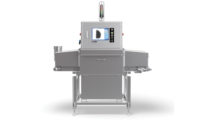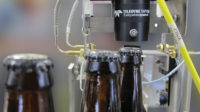Inspection equipment helps uphold quality and brand integrity
Inspection equipment gives lightweight packages special treatment

Teledyne TapTone’s TotalVu vision sensor offers no-touch package inspection by using up to four “smart” cameras to capture multiple inspections in a single pass at speeds as fast as 2,000 containers a minute. (Image courtesy of Teledyne TapTone)

FT System’s PCS700 leak inspection system passes a laser beam through the head space of beverage containers to inspect internal pressure. (Image courtesy of FT System)

Mettler-Toledo CI-Vision’s new Bottle Contaminant Detection System uses multiple cameras and proprietary software to complete multiple inspections on empty plastic bottles simultaneously. (Image courtesy of Mettler-Toledo CI-Vision)



At retail, beverage packages are tasked with not only displaying an attractive shelf presence but also ensuring the quality of the product and the integrity of the brand. “Quality is fundamentally about building and maintaining your name in the market,” says Mike Lawn, director of BBull USA Inc., Oldsmar, Fla. “It can take years to develop, but with today’s global socialized media, it can be lost with just one incident.” For this reason, it is important that beverage-makers employ inspection equipment to keep product quality in-check, he says.
Concerns for consumer safety are one of the major drivers for wanting to ensure quality by incorporating inspection equipment into production lines, says Rick Reardon, manager of FT System North America, Suwanee, Ga. For example, it is important to check all empty containers for foreign objects and check glass bottles for chips or cracks prior to filling in order to prevent safety issues down the road, he says.
Damaged containers also can cause backups on the production line. “Dented cans or damaged sealing rings cause crashes within the filler or sealer, resulting in potential damage to equipment [and] down-time and requiring lengthy clean-up processes,” BBull’s Lawn explains. To prevent imperfect material from entering the production stream, BBull offers its Cankon vision inspection system, which is designed to remove damaged containers from the system before they enter the filling block as well as detect and reject empty containers with contaminants inside them, he says.
Early inspection for damaged containers also helps improve the flow of production and can even reduce further damage to the product or other products in close proximity, says Tim Kelley, vice president of marketing for Tri-Tronics Co. Inc., Tampa, Fla. Manufacturers can use any of Tri-Tronics’ non-contact sensors to track and identify products that don’t meet brand standards and remove them, he says.
Aurora, Ill.-based Mettler-Toledo CI-Vision launched in May its new Bottle Contaminant Detection System to inspect blown bottles for defects. The system uses multiple cameras and proprietary software to complete multiple inspections on empty plastic bottle sidewalls or bottoms simultaneously, including checking for manufacturing defects and inclusions that can lead to problems in filling and capping or adversely affecting a product’s shelf presence, the company says. It also offers quick changeovers with only a few operator adjustments through the human-machine interface for different bottle sizes to offer added flexibility, it says.
With beverage cans, it’s also important to check the seams for leaks, according to Maura Marcks, marketing manager for CMC-KUHNKE Inc., Albany, N.Y. The company recently released its patent-pending SEAMscan XTS non-destructive double seam inspection unit for beverage cans. The XTS uses low-power, non-destructive X-rays to virtually tear apart the can to measure the tightness of the double seam without actually cutting the can, thus preserving samples for further testing and sale, Marcks explains.
As cans of different sizes flood the beverage market to help meet consumer needs and add a differentiated shelf presence, can seam inspection equipment must flex to ensure quality across all of these packages, CMC-KUHNKE’s Marcks says. To accommodate this, CMC-KUHNKE designed all of its semi-automated inspection systems to work with a wide range of cans, she says. For example, its CSG-2360 combination seam gauge is designed to automatically adapt to different can diameters and is able to operate independent of can height to facilitate inspection of these different sizes, she explains.
The continuing trend of lightweighting packaging also is influencing the operation of inspection equipment, experts note.
“The lightweighting of metal cans presents an increasingly more difficult inspection,” says Melissa Rossi, director of marketing for Teledyne TapTone, North Falmouth, Mass. When cans were made with a thicker amount of metal, they were frequently tested using proximity technology that would scan the top of the can and inspect the lid’s curvature to check the pressure inside the can, she explains. However, this method is not as accurate with lightweight cans, she says.
Today, Teledyne TapTone employs pressure inspection systems that minimally touch a can’s sidewalls with soft-touch belts to inspect the can without damaging it, Rossi explains. It also offers no-touch inspection technology through equipment like its TotalVu vision sensor, she notes. This system includes as many as four “smart” cameras that capture multiple inspections, including label inspection, tamper ring inspection, cap inspection, date and lot code verification, visual fill-level inspection, and 1-D and 2-D barcode verification, in a single pass at speeds as fast as 2,000 containers a minute, according to the company’s website.
FT System’s Reardon says he thinks that the lightweight packaging trend will push the inspection equipment industry toward no-contact systems. As part of this, the company offers its PCS700 leak inspection system, which utilizes a patented tunable diode laser absorption spectroscopy technique. Instead of touching the package, the system passes a laser beam through the head space of the container to inspect internal pressure, he explains.
Stephen Dryer, product manager for Aurora, Ill.-based Mettler-Toledo CI-Vision, also notes that automated vision inspection equipment is becoming “an indispensible tool” for no-touch inspection of lightweight packages by instead using cameras and lights. Machine vision inspection equipment can be used to verify that packages are correctly labeled, filled to the appropriate level, and properly capped and sealed with tamper-evident bands without damaging the package, he says. This allows the next inspector in the production process to be the end-consumer when he or she picks up the product on the shelf, he adds.
Finding the value
Despite the importance of sending a quality product to the shelf, the economy has been an obstacle in preventing some beverage-makers from incorporating inspection systems into their production lines, BBull’s Lawn says. “Cost justification of inspection equipment is sometimes complex and somewhat adjective,” he says. To help determine the value of inspection equipment to a specific supply chain, Lawn suggests the following questions for consideration: Will under-filled containers or crooked labels affect sales? If so, by how much? How many leaking containers can be tolerated before your major distributor starts looking elsewhere? What is the likelihood of a glass fragment causing serious harm? How many recalls will there be for letting incorrect labels leave the facility?
To help customers ensure that they are investing in the right kind of inspection equipment, Mettler-Toledo CI-Vision’s vision lab helps design the proper combination of vision inspection equipment, including specific combinations of timed lighting and optics, before purchase. “We can validate a vision solution that will meet our customers’ needs before any money has been spent, meaning that the risk of investing in machine vision is minimized upfront,” Dryer explains.
In order to reap the most benefits from inspection equipment, manufacturers should enlist the services of inspection companies right from the start of a new container design, Teledyne TapTone’s Rossi says.
“We’ve had customers approach us with containers they’ve already designed on lines they’ve already built to find that the container’s not testable, and they’ve had to go back to the drawing board,” she says.
This partnership not only saves customers time and money, but it also helps the inspection equipment industry to develop based on the challenges presented by customers, she says.
Looking for a reprint of this article?
From high-res PDFs to custom plaques, order your copy today!












